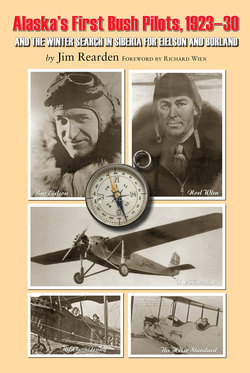Читать книгу Alaska's First Bush Pilots, 1923-30 - Jim Rearden - Страница 9
На сайте Литреса книга снята с продажи.
ОглавлениеIntroduction
This book is a look back at Alaska’s earliest aviation, mostly at Fairbanks, where the first commercial flights were made by Ben Eielson with a World War I JN4 (Jenny) open cockpit biplane. In addition to its pilot, who flew from the rear cockpit, everything it could fly had to fit into that airplane’s front cockpit.
Eielson was the first in Alaska’s Interior to demonstrate that airplanes were more than a unique source of entertainment. Early commercial pilots, soon called “bush pilots,” were looked upon as heroes; “bush pilot” is still an honorable title in Alaska.
For landing places, the first pilots used river bars, baseball fields, and race tracks (first used by horses, later by cars, finally by airplanes). Their airplane motors (the early name; “engines” today) were cranky and liquid-cooled. Power failures were common. Landings on rough ground often resulted in a broken propeller, damaged landing gear, a crushed radiator, and mangled tips of the lower wings of the biplanes they flew. Prepared pilots always carried an extra prop lashed to the side of the fuselage.
To fly, pilots must have visibility. There were no weather forecasts for the early birds. A pilot might depart under blue skies, and a hundred miles and an hour-long flight away be forced by fog or heavy snow to land. Airplanes had no radios. Once in the air, a pilot was out of touch, and on his own. In the early years it took nerve and self-confidence for a man to climb into the cockpit of a biplane and embark on a flight across the wild land that is still much of Alaska.
Airplanes were commonly forced down by weather, lack of fuel, a lost pilot, or mechanical problems. A communication system that we of today would regard as primitive saved the day for many a pilot. In 1922, and for years after, there were forty-eight U.S. Army Signal Corp stations in the Territory manned by 250 men and officers. They operated a mixture of telegraph and Morse-code-type radios in villages and remote stations. Telegraph wires were strung almost Territory-wide on the mainland. An underwater cable lay on the sea bottom between Southeastern Alaska towns and Seattle; a telegraph line connected Fairbanks and Seward.
It’s winter, flying from Fairbanks, your plane noses over during a landing, and your metal prop hits the ground and is bent and unusable. If it is wood it has shattered. You hike along a dog team trail that is brushed out and maintained by the Territory, and maybe you’ll get a dog sled ride, maybe not. Usually within a few days you arrive at a village or roadhouse with a telegraph or radio station where you can send a message to Fairbanks.
If a prop can’t be sent by plane, it will arrive via dog team. It might be a scheduled dog team mail sled, or a hired dog team. This might take weeks, but that’s the way life was then.
By the late 1920s cabin planes had started to replace the inefficient and frigid cockpits. Some of these planes had reliable air-cooled engines. At the same time, high wing monoplanes started to replace the biplanes.
In the beginning, the various commercial aviation companies and their pilots and mechanics resembled a small, sometimes quarrelsome family. Pilots and mechanics commonly changed from one company to another. Pilots often flew the planes of competing companies and no one though it unusual. When a pilot and his plane went missing, other pilots, with few exceptions, and regardless of company loyalty, participated in the aerial search for him.
In November, 1929, world-famous pilot Ben Eielson and his mechanic, Earl Borland, flew from the tiny coastal Alaska village of Teller into a snowstorm that raged over the Bering Sea. They were bound for the ice-locked trading ship Nanuk in Siberia which held a cargo of valuable furs. They were to fly the furs to Fairbanks to be transshipped to the New York fur market.
Their airplane didn’t arrive at the trading vessel, nor did it return to Teller.
The winter search for the missing plane became the climactic Alaskan aviation event of the 1920s that was followed in news accounts by millions around the world. Between fierce storms searching pilots clothed head-to-toes in fur flew through brutal deep cold in open-cockpit biplanes. Daylight hours were dim and brief, for the sun remained below or close to the horizon.
Searching pilots first had to cross sixty miles of the ice-choked Bering Sea between Alaska and Siberia. They then followed the wild and barren Asian coast 375 miles to Nanuk, the base from which they flew their searches. Every foot they flew posed major flight hazards.
Today, despite the advances in quality and dependability of airplanes, even modern pilots would consider such flying as extremely risky.
It was late January before the missing plane was found.
Alaska’s aviation family of the 1920s included heroic and bold pilots. They had to be adventuresome to do the flying they did. Those early fliers well-deserved the praise and affection bestowed upon them.
In this volume I have portrayed a handful of these men, concentrating largely on a few who pioneered aviation in Alaska’s vast and rugged Interior, and who also participated in the search for the lost Eielson and Borland.
Alaska’s aviation industry was a struggling infant during the 1920s. Eventually it became a giant upon which today’s rural and not so-rural Alaskans are totally dependent. What would modern Alaska be without airplanes and bush pilots?
— JIM REARDEN
SprucewoodHomer, Alaska
